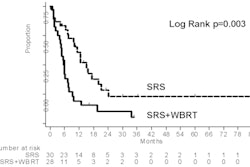The radiation oncologist at the center of a scandal over prostate brachytherapy procedures performed at a Philadelphia Department of Veterans Affairs (VA) hospital found himself on the hot seat in hearings before the U.S. Congress on July 22.
Dr. Gary Kao, Ph.D., testified before the U.S. House of Representatives Committee on Veterans' Affairs oversight and investigations subcommittee regarding allegations contained in a New York Times article in June on quality problems within the VA's prostate brachytherapy program.
The newspaper charged that the Philadelphia VA Medical Center (VAMC) "botched" 80% of the prostate brachytherapy procedures it performed over a six-year period. It also said that other VA hospitals had problems with their brachytherapy programs.
Kao's testimony
This was the second time that Kao testified before a congressional committee. On June 29, he appeared at a field hearing held at the Philadelphia VAMC by the U.S. Senate Committee on Veterans' Affairs. At that time, Kao stated that he did not believe that significant medical errors had occurred during the procedures, and that although he could have done a better job of placing some implants, his patients overall received effective treatment for their prostate cancer, according to a New York Times report.
The Philadelphia VAMC started its prostate brachytherapy treatment program in 2002, and contracted with the University of Pennsylvania's radiation oncology department to manage it. The contract was renewed an additional four times until the program was shut down in May 2008 by the Veterans Health Administration after an investigation discovered previously unreported medical events.
Reading a prepared statement at the July 22 congressional hearing, Kao stated that he and his colleagues from Penn's radiation oncology department had developed precise standard operating procedures and a system of oversight and monitoring of what he characterized as a state-of-the-art treatment.
Kao denied that deficient care was routinely rendered to patients, and stated that the characterization of "botched cases" was "simply wrong -- unfair and extremely misleading."
"The efficacy of the treatments is evidenced by the fact that there were no confirmed cases of tumor recurrence at the time the program was terminated in 2008, with many patients doing well up to five years after their brachytherapy treatment," Kao stated.
An investigation of the incidents by the Nuclear Regulatory Commission (NRC) determined that 35 patients received radiation doses to other parts of the body, and the implants of 57 patients delivered too little radiation to the prostate, either because the seeds missed the prostate or were not distributed properly inside the prostate.
At least seven patients were sent by the Veterans Health Administration to receive additional treatment at its most experienced brachytherapy treatment facility in Seattle. When questioned directly by subcommittee chairman Rep. Harry Mitchell (D-AZ), E. Lynn McGuire, director of the VA's National Health Physics Program, testified that six of the patients had biochemical failure and an additional eight patients were experiencing rising prostate-specific antigen levels.
No witness at the two-and-a-half-hour hearing detailed the complications that some of Kao's patients had allegedly sustained. At least three patients have publicly talked about the toxicities they experienced, including burns and permanent urinary and bowel problems.
When should events be reported?
In his testimony, Kao discussed the topic of what constitutes a reportable medical event, focusing most of his testimony on the definition's ambiguity and how this could reduce the 92 reportable medical events as defined by the Nuclear Regulatory Commission to a much lower number. He testified that he felt the number of reportable medical events would be closer to 20.
A standard definition of a reportable medical event as it applies to brachytherapy did not exist in 2002, according to Kao, nor did the NRC investigators clarify the definition in 2003 or 2005. The definition that the NRC has retroactively applied for prostate brachytherapy is based on a dose received by 90% of the prostate, but this definition does not appear anywhere in regulations published by the NRC, Kao contended. He also stated that the definition was evolving based on discussion within the NRC.
In subsequent testimony, Dr. W. Robert Lee, professor of radiation oncology at Duke University School of Medicine in Durham, NC, had a different opinion. "A medical event at Duke is defined as the wrong patient, the wrong dose, the wrong organ, or the wrong isotope," he said. Lee is past president of the American Brachytherapy Society (ABS) of Reston, VA, and also testified on behalf of the American Society for Radiation and Oncology (ASTRO) of Fairfax, VA.
Lee said that of the approximately 50,000 prostate brachytherapy procedures performed annually in the U.S., only 0.22% resulted in a reportable medical event. The procedure has had a very low complication rate, even as early as the 1990s, Lee noted.
Kao also did not feel that a reportable medical event, whatever its definition might be, was reflective of the quality of treatment provided. "Whether brachytherapy treatment has been delivered with the standard of care should not be determined by whether the treatment resulted in a reportable medical event to the NRC," he declared.
He supported this statement by saying that such significant factors that determine appropriate treatment include the number of seeds; the location of the seeds inside and outside the prostate; the size and shape of the prostate; the stage, grade, extent, and location of the cancer; and the clinical follow-up of prostate-specific antigen test results. These factors are not addressed by the NRC, he said.
At least one representative was frustrated by Kao's line of testimony.
"I'm thinking you're in a dream world right now," Rep. John Adler (D-NJ) told Kao. "How do you reconcile your view with everyone else? I want you to acknowledge that you did things less well."
But the only thing Kao acknowledged that he would have done differently was to stop the program instead of continuing it for a 12-month period when postimplant dosimetry information could not be obtained due to a computer interface problem between the CT scanner and Kao's workstation. He testified that he complained to the radiation safety officer, the chairman of the Philadelphia VA's radiation oncology program, and his colleagues, but nothing was done to correct the problem.
Kao's rationale for continuing to perform brachytherapy procedures was that for some patients, the choice for prostate cancer treatment was brachytherapy or no treatment, because many patients, especially out-of-state patients, could not take time off from work for weeks of daily radiation therapy treatment.
University of Pennsylvania's explanation
Dr. Stephen Hahn, chairman of the radiation oncology department at the University of Pennsylvania School of Medicine, apologized for the program and defended it.
He testified that the department first learned of the problems in May 2008, and took what he said was immediate action. The department provided several faculty members and staff to assist with a quality review of all prostate brachytherapy cases, and the department has coordinated patients' follow-up care.
"In June 2008, we also reviewed quality control and improvement measures to determine whether we could enhance them to prevent a situation like this from ever happening again," Hahn stated in his prepared remarks.
The quality review process now includes peer review of the CT scan and a recalculation of the delivered dose for each patient, as well as establishing a multilevel internal reporting system so that even slight anomalies will be reported to and reviewed by Penn's quality assurance committee.
The Hospital of the University of Pennsylvania began to transition to "real-time dosimetry" in 2008, enabling calculation of the dose delivered to the prostate after each radioactive seed is implanted. Hahn stated that if the Philadelphia VAMC restarts its permanent prostate brachytherapy program, his team would help the VA's radiation oncology program modernize along these lines.
When asked by subcommittee members if a severe breakdown in peer review occurred, Hahn stated that the department depended upon the local treatment team to report issues without having a secondary look by external doctors and physicians. "What we learned about this was that we sensed this was a joint responsibility of oversight, and sometimes there is a lack of clarity," he said.
By Cynthia E. Keen
AuntMinnie.com staff writer
August 10, 2009
Related Reading
Congress eyes safety of VA prostate brachytherapy: Part 1, August 6, 2009
VA radiation oncologist admits mistakes, July 1, 2009
NY Times story claims treatment errors at VA brachytherapy unit, June 23, 2009
Copyright © 2009 AuntMinnie.com



















